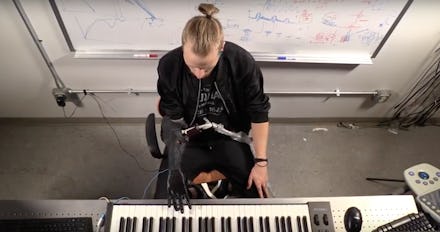Watch this high tech prosthetic arm help a musician play the piano and drums again

Prosthetics are becoming increasingly sophisticated, thanks to breakthroughs in science. Humanity has officially progressed from the iron-clad, sword-gripping prosthetics of the 1500s to robotic hands that can give a musician the chance to play instruments again.
At the Georgia Institute of Technology, researchers are working on a more nimble, sensitive and accurate prosthetic that they’ve playfully compared to Luke Skywalker’s bionic hand. So far, they managed to successfully suit up Jason Barnes — an amputee who lost part of his right arm in 2012 — with the ultrasound-powered prosthetic.
Like most commercial prosthetics, Barnes’ old one has electromyogram censors attached to muscles to communicate how the arm should move. The problem, however, is that “EMG sensors aren’t very accurate,” Gil Weinberg, director of Georgia Tech’s Center for Music Technology, said in a release.
“They can detect a muscle movement, but the signal is too noisy to infer which finger the person wants to move,” he said. “We tried to improve the pattern detection from EMG for Jason, but couldn’t get finger-by-finger control.”
Weinberg’s new arm, however, is much more sensitive because of its use of ultrasound signals and machine learning. Algorithms rapidly figure out which fingers Barnes is trying to move, and that along with the ability to simultaneously move various fingers is what allows the musician to key agin.
“Ever since I got on it and played the piano with all five of my fingers individually, it was completely mind blowing – just unheard of,” Barnes said in a video. “I never thought that we would be where we are now with individual finger control.”
In 2014, Weinberg showed the world a prosthetic that helped Barnes return to playing the drums, as well.
“If this type of arm can work on music, something as subtle and expressive as playing the piano, this technology can also be used for many other types of fine motor activities, such as bathing, grooming and feeding,” Weinberg said. “I also envision able-bodied persons being able to remotely control robotic arms and hands by simply moving their fingers.”